Over the past nine hundred years, the Muirheads of Bothwell, Cumbernauld, Lauchope and Bredisholm, and their descendants, have served their deities and their fellow man with devotion, courage and humility. Our surname, Muirhead, like many others, is believed to come from the place where our ancestors lived - from the muirs, or moors, of Scotland. More particularly from the head, or edge of the moor.
In his highly authoritative book, "The Surnames of Scotland, Their Origin, Meaning, and History", first printed by the New York Public Library in 1946, Dr. Black had this to say about our surname:
"MUIRHEAD, Morehead. From one or other of the many localities of the name in the southern counties, perhaps from Muirhead in the barony of Bothwell. The lands and town of Mureheid in the diocese of Ross are mentioned in 1578 (RPC.), but the surname is not likely to have originated there.The first of the name on record is said to have been Sir William Muirhead of Lachope, end of the fourteenth century. Probably the same person as William de Murehede who witnessed a charter in lands of Cranshaws in 1401. (Swinton, p. xvii). Andrew Morheid was assizer in Lanark in 1432 (RAA., II, 65), David de Murhed, cleric in diocese of Glasgow, is recorded in 1471 (REG., 395), Ricardus Mwreheid, canon of Dunkeld, 1484 (RAA., II, p.211) may be Richard Murhede, dean of Glasgow in 1491 (AAPS., II, p. 270), Wilyame of Murehede is recorded in 1484 (Peebles, 31), and Thomas Murhede was parson of Lyne in 1504 (Trials, I, p*43). Thomas Murehead, quarryman at Dunkeld, 1505-15, appears in record as Moirhed, Moirheid, and Mored (Rent, Dunk.), David Muirheyd was assizer in Gowane (Govan) in 1527 (Pollock, I, p. 268) and David Mourheid was merchant burgess of Dumfries, 1668 (Inquis., 938). In common speech pronounced Murheed, Mooreheid 1624, Morheid 1691, Mureheid 1620, Muirhed 1513, Murehed 1503, Muyrheid 1498, Mwirheid 1577, Mwreheid 1484, Mwrhed 1493, Mwrheid, Mwrhied, and Mwrheyd 1522."
The above information was recently corroborated by Lieutenant Colonel Howard C. Paterson, TD, a Fellow of the Society of Antiquities of Scotland, in a letter to our Clan President and Chief Elect, Raymond Lee Morehead, Esq.
As can be seen from the paragraph above, the pronunciation and spelling of our surname was changed, in some cases, to Muirheid, Morehead, Moorhead. These changes occurred as the descendents of the family moved to other locales, e.g., to the southwest of Scotland, to Ireland, and as in the case of James and John Muirhead-banished, in 1685, to the English colonies in North America because they refused to swear allegiance to King Charles II, an avowed Papist, and had fought against the British crown for their religious freedom as Covenanters at the Battle of Bothwell Bridge. [1679].
In his book, "A System of Heraldry", Nisbet states, "The first charter I have seen of any note concerning the ancient family is a deed granted by Archibald, Comte de Douglas Galovidiac et Bothwell, dicto soutiforo, Sieur Willielmo deMuirhead in Baronia de Bothwell in 1393, being a gentleman of mettle and spirit, he had the honour of Knighthood conferred on him by King Robert III."
Legend tells us that the king knighted William Muirhead and awarded him the lands of Lauchope as a reward for having brought him the head of one Bertram deShotts, a ferocious killer who had terrorized the region for years. The king had issued a proclamation which said that whoever rid the area of this killer would be rewarded. Muirhead cut and stacked a large pile of heather near the spot where Bertram used to go to get a drink of water. As time passed, Bertram, initially wary of the heather pile, became accustomed to its presence. William Muirhead, with his big, two handled sword, hid in the pile of heather, and as Bertram lay on the bank of the stream to get a drink of water, Muirhead quickly advanced upon him and with his sword, slashed Bertram's hamstrings - behind his knees, so the mad giant was helpless. Bertram laughed at Muirhead, who is reported to have said to him before he beheaded him with his sword, "Lauch up, for its yer last laugh!" . Thus we get the name of Lauchope.
Lauchope House, a tower house noted for its extremely thick walls, gave refuge to Hamilton of Bothwellhaugh, brother of Janet Hamilton, wife of James Muirhead, of Lauchope[1510- ?], as Hamilton fled after slaying the Regent of Scotland, the Earl of Moray, half-brother of Mary, Queen of Scots, in 1570 at Linlithgow. The House was set ablaze by those who sought to revenge the killing of the Regent and many important papers were lost in the blaze. In 1799, part of the house fell, and in 1956, the present owners, the Roberton family, one of the oldest, untitled families in Lanarkshire, had the property demolished.

Points Sketch of Lauchope 1596
Pont's sketch of the area of Lauchope in 1596 (shown above) indicates 5 stories by the window count and a keep, (Tower) showing it was was of a very significant size indicating 7 stories by window count (The original map Image courtesy of Gordon Mason)
Based on the above Image I have tried to render a drawing of Lauchope during this period. A artistic representation of the Muirhead Scottish seat. Other than this 1596 image, to date no other known images have been found prior to its destruction.
The Runes of Lauchope Tower House is site NO. OS64 NS781617 3.5 miles north east of Motherwell, off minor roads, north of A8 and south of B799, south of Chapelhall and south east of Lauchope mains. http:canmore.org.uk/site/45791.
The following image is only my artistic representation of Lauchope could have looked like prior to 1596. Having consulted with several historical people in Scotland, this is my representation. I am not an architectural artist nor profess that my representative drawing is a correct, detail drawing nor did I intended to be. It is I think a fair artistic pencil rendering of what the 1596 sketch of Lauchope could have looked like, the onetime historical seat of the Muirhead Clan.


Lauchope House 1921
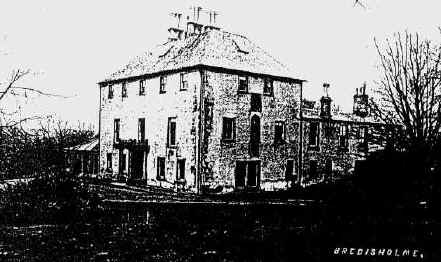
Bredisholm House 1878
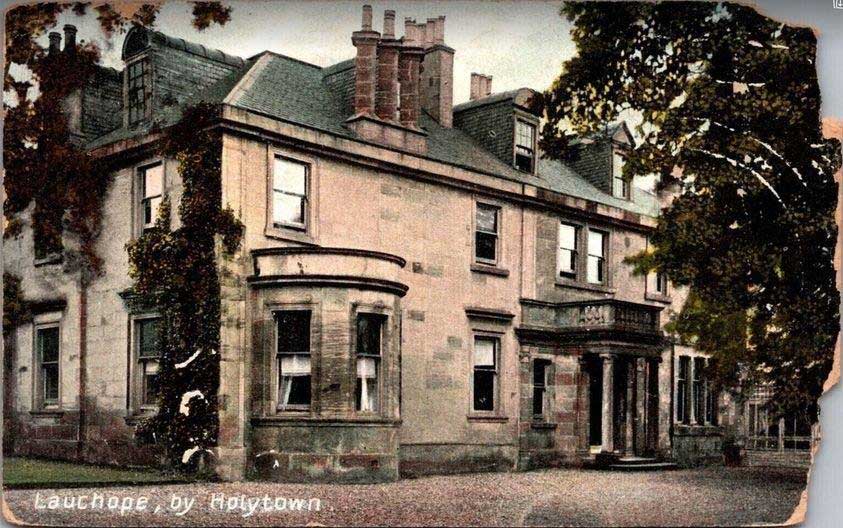
Lauchope - Credit Maxine Ross, Scotland
For additional Lauchope House
Pics
<Click Here>
A photograph of the stately and
historic Lauchope House, seen in its sylvan setting during the early
1900's, (Many thanks to Robert Lindsay Muirhead for his contribution
of the picture of Lauchope House) as well as an old photograph of
Bredisholm House, which was located on what is now the Glasgow Zoo,
have come to hand. [Bredisholm, or Breadiesholme, was located east
of the junction of motorways M2 and M8 and on the north bank of
Calder Water; the house, which in its later days served as a golf
clubhouse, was also demolished at about the same time as Lauchope
House] Again, according to Nisbet, "The family of Muirhead of Lauchope has always been reputed one of the most ancient families in all the shire of Lanark.."
Walter Grosset, of Logie, a large estate, owned by the Grosset family from 1711 to 1760, in the village of Crossford, near Dunfermline, in his volume, "An Account of the Family of the
Muirheads of Lachop" n/d., circa 1740, in similar fashion, outlined the Muirhead family history and the inter-familial connections with the Grosset family of Logie.
Walter's mother, Euphemia Muirhead, also known as Lady Logie, the eldest of the six children born to James Muirhead and Helen Stewart, of Bredisholm, married Archibald Grosset,
of Logie, circa 1707. When her four brothers failed to produce any heirs, the Muirhead line of descent then followed the female line, and one of her sons, James Grosset, a merchant prince of Lisbon, Portugal, in 1754 purchased the Bredisholm estate from his uncle, John Muirhead of Bredisholm [1676-1762] , and assumed the Muirhead surname and its coat of arms, for himself 'and his posterity'. Among the descendants of John Grosset Muirhead is Dr. James Steuart Muirhead-Gould, one of the current elders of the clan. [Logie has been in the possession of the
Hunt family since 1788]. Below is a picture of Logie.
James Grosset Muirhead [1706-1776] is also credited with the recovery of the ballad of the "Laird of Muirhead" which recounts the story of the defeat of the Scottish army by the English at the Battle of Flodden, in 1513. The Muirhead clan had the signal honour of serving as King James IV of Scotland's royal bodyguards during the battle. King James, and his son, Alexander, were both slain, along with the flower of Scottish chivalry, including the Laird of Muirhead, John Muirhead [ca. 1443-1513], and over two hundred of his clansmen also perished in the battle.
This ballad is on display at the oldest house in Glasgow, built in 1471 by Bishop Andrew Muirhead, the First Provands Lordship of Glasgow, as a church manse near Glasgow Cathedral. Mary, Queen of Scots, is reported to have spent a few days at the manse. This ballad is a fragment from Mr. Herd's MS., communicated to him by J. Grossett Muirhead, Esq. of Bredisholm, near Glasgow; who stated that he extracted it, as relating to his own family, from the complete Song, in which the maes of twenty or thirty gentlemen were mentioned, contained in a large collection, belonging to Mr. Alexander Monro, merchant in Lisbon, but supposed now to be lost. It appears, from the Appendix to Nisbet's Heraldry, p. 264, that Muirhead of Lachop and Bullis, the person here called Laird of Muirhead, was a man of rank, being rentaller, or perhaps feuar, of many crown-lands in Galloway; and was, in truth, slain in "Campo Belli de Northumberland suv vexillo Regis," i.e. in the Field of Flodden.
|
The Laird
Of Muirhead The Poetical Works of Sir Walter Scott Minstrelsy of the Scottish Border Edinburgh; Adam and Charles Black, 1861 ~*~*~*~ Afore the King in order stude Before, stood The stout laird of Muirhead, Wi' that same twa-hand muckle sword two-handed great That Bartram fell'd stark dead. (relates to the legendary story of the capture and decapitation of a ferocious killer, Bertram DeSchotts, by an earlier Laird of Muirhead.) He sware he wadna lose his right swore, wouldn't To fight in ilka field; each/every Nor budge him from his liege's sight, lord's Till his last gasp should yield. Twa hunder mair of his ain name, two, more, own Frae Torwood and the Clyde, From Sware they would never gang to hame, swore, going, home But a' die by his syde. side And wondrous weel they kept their troth; well This sturdy royal band Rush'd down the brae wi' sic a pith, hill with such force That nane could them withstand. none Mony a bloody blow they dealt, The like was never seen; And, hadna that braw leader fall'n, had not, brave They ne'er had slain the king. ~*~*~*~ |
|
|
Following the union of the crowns of
Scotland and England in 1603, when James VI of Scotland
ascended the English throne, and became James I of England,
and following the subsequent
political union which followed in 1707, when the Scottish Parliament dissolved in Edinburgh, and merged into the first British Parliament in London, the fortunes of the Muirhead family tended to follow that of the expanding British Empire. They acquired a home in Hanover Square, in London. Other family members emigrated to the now British colonies around the world. Some, like John Muirheid, mentioned earlier, who gained prominence in Mercer County, New Jersey and was the first sheriff of Pennington, New Jersey; others, the Moreheads of Galloway, for example, settled in the colonies of Virginia and the Carolinas; a contingent of Muirheads settled in Nova Scotia, and other Muirheads settled in other provinces of Canada. In the passage of time, Muirheads and Moreheads moved westwards into Kentucky, Tennessee and to the other states and provinces, as opportunities presented themselves. One family, that of James Muirhead [1740-1804] and his wife, Elphinstone MacKinnon, settled in Adelaide, in South Australia, and made a considerable mark in that part of the world. Muirheads have served their old and new homelands well; among the numerous attainments of this distinguished family have been, before the Reformation, Bishops of the Roman Catholic church, Deans of Glasgow University, Provosts [Mayors] of Hamilton and Glasgow, three Governors of the state of Kentucky, the discovery of the power of steam by James Watt, the great Scottish inventor, whose mother was Agnes Muirhead of Lachop, to the 1998 Engineer of the Year, Brian K. Muirhead, of the Mars Rover vehicle fame. Another, Major John Motley Morehead, a scientist and engineer for the Union Carbide and Carbon Company, of New York, was a discoverer of acetylene gas. He also wrote, "The Morehead Family of VA and NC", in 1921. More recently, Ray Jerome Morehead, who spent forty years researching the Muirhead history , wrote a book, "The Henry Muirheid/Muirhead Family of Virginia and Mississippi", in 1989. [The book is available for purchase through his son, Raymond Lloyd Muirhead] . Another Muirhead of note, Roland Eugene Muirhead, founded, and served as the first president of, the Scottish Nationalist Party [SNP]. The SNP is presently a major political force in the new Scottish Parliament which opened its first session in Edinburgh in 1999, after an absence of 292 years. Captain Charles Morehead [1609-1705], the eldest child of David Muirhead, a wealthy merchant with business offices in both Edinburgh and London, emigrated to Kent Island on the Chesapeake River in 1630 to oversee his father's enterprises in the English colony of Virginia. It is located just east of the US Naval Academy at Annapolis, MD. He subsequently moved, in 1645, to Great Wicomico, in Northumberland County, Virginia. 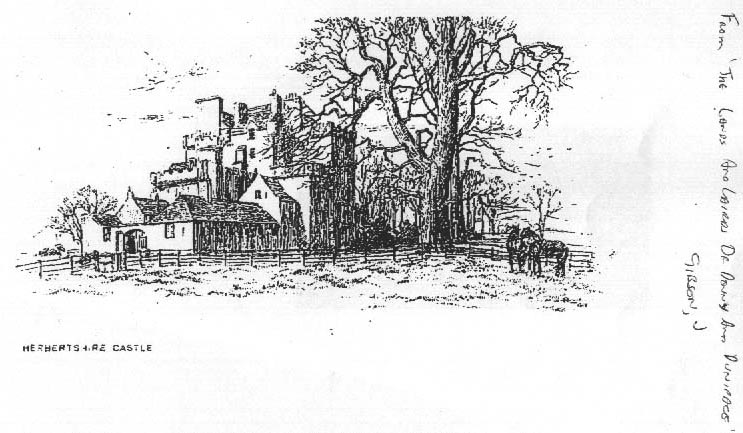 Near Denny, lies Herbertshire, one of the grandest embattled residences in the country. Although the date of its erection is unknown, reliable records inform us that it was originally a hunting station, and given by an early James to the then Earl of Wigtown, as his halbert-share for services rendered in war. In the fifteenth century, the estate was in the possession of that once powerful family the Sinclairs, Duke of Orkney. In the following century, it became the property of the Earls of Linlithgow, from whom it passed into a family named Stirling, cadets of the Stirlings of Auchyle, in Perthshire. Then an heiress of this surname sold it about 100 years ago to a William Morehead, the new Laird of Herbertshire, the grandson of John Muirhead, Bailie of Hamilton, descendant of the Muirheads of Lauchope. He succeeded to considerable property on the death of his father’s cousin, William Morehead (the first, it appears, to change his name to Morehead) of Cavendish Square, London, in 1767.  He married, in 1768, Isabella, daughter of John Sinclair Lockhart of Castlehill and Camnethan, in the county of Lanark, and granddaughter of Sir John Sinclair of Stevenson, Bart. They had at least three sons 1. William, who succeeded to Herbertshire, 2. John, and 3. Robert; and a daughter, Charlotte Martha. There are interesting notices of the family and estate in the "Life and Writings of the Rev. Robert Morehead, D.D." William Morehead died in June, 1793, and appears to have been a close friend of Lord Jeffrey, as a characteristic letter from Lord Jeffrey to John Morehead demonstrates. Copy from a book provided by Falkirk Council, Museum Services, Callender House. Herbertshire Castle and estate was disposed of in 1835 to the father of the present proprietor, William Forbes, Esq., of Callendar. The banks of the Carron here are very picturesque, sloping in stripes of verdant meadows, tufted with trees to the water’s edge, and rising boldly into rocks fringed with brushwood and crowned with plantations. Herbertshire Castle was demolished several years ago. 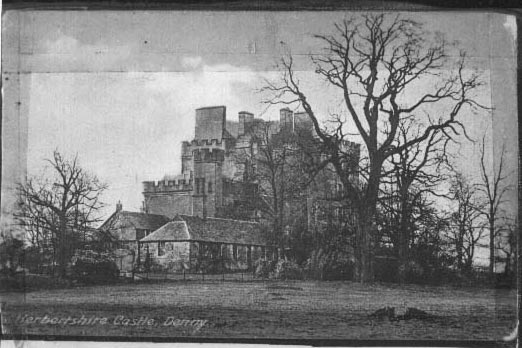 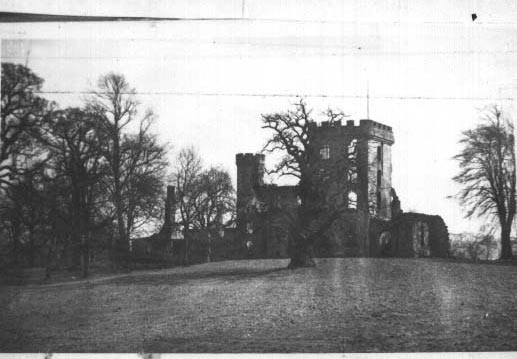 Photos and drawings still survive and are archived at the museum. Pictures from the Falkirk Council Museum Services Jonathon Muirheid, of Hunterdown County, New Jersey, personally led General George Washington to the most suitable site on the Delaware River from which spot the general launched his first successful attack on the British forces in Trenton during the Revolutionary War. Many members of the Muirheid family served with great distinction in the American Revolution, including one who rose to the rank of Brigadier General. In the Civil War, a Morehead was Chief of Staff to General Sherman of the Union Army. There is much more to the history of this ancient Scottish family than is contained herein. Let us do our best to follow in the footsteps of our ancestors in piety, honor and comradeship. As our Chief Elect, Raymond Lee Morehead, Esq. urges us, "Remember the men and women from whence you came, for, in remembering them, they live once again for all those who follow." For additional facts and history shorts <Click Here>
|
